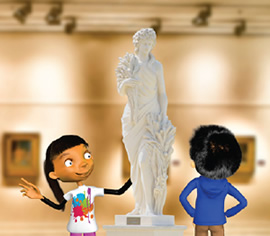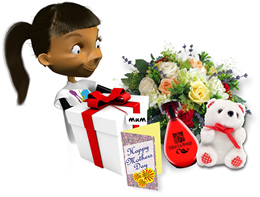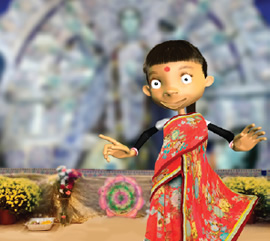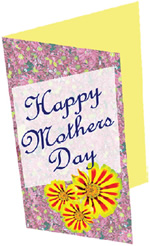Mother’s Day is a special day when we can celebrate the special people in our lives. They can be your mother, sister, cousin, grandma, aunt, a family friend or even a teacher.
- Mothers throughout history
- How did Mother’s Day begin?
- Mother’s Day around the world
- Mother’s Day fast facts
- References
Mothers throughout history
How do you celebrate Mother’s Day? Do you make breakfast in bed for your mum, or give her a card or gift? Although these are common things to do in Australia today, mothers have been celebrated in many different ways for a very long time.
Ancient times

In ancient times (thousands of years ago), many cultures would celebrate a mother goddess whom they thought of as the mother of everyone.
In ancient Egypt, Isis was worshipped as a mother goddess and in Greece they worshipped a goddess named Rhea.
Festivals to celebrate mother goddesses were usually held in Spring because it represents new life and fertility. An example of one such celebration was the Roman festival of Hilaria that honoured the mother goddess Cybele.
In many places around the world, Mother’s Day is still celebrated in Spring, but in Australia we celebrate it in Autumn.
Mothering Sunday
During the 1600s in England, the fourth Sunday of Lent (the time just before Easter) became known as Mothering Sunday. On this day Christians honoured Mary, the mother of Jesus, by decorating churches with flowers and jewels.
Soon, the Mothering Sunday celebration began to include the celebration of actual mothers too. On this day, maids and servants were allowed to travel home to visit their mothers. Often they would bake a simnel cake, filled with spices and fruit, as a gift. Families would eat lots of food and give small presents to their mothers.
How did Mother’s Day begin?

Two women, Julia Ward Howe and Anna Jarvis started Mother’s Day (as we know it today) in North America.
In 1870, a time of civil war in America, Julia Ward Howe wanted to create a special day to encourage mothers to come together in peace to try and stop their sons from fighting against each other. This version of Mother’s Day only lasted a few years.
In 1908, Anna Jarvis worked hard to get an official Mother’s Day. She succeeded, and was also responsible for making the white carnation a popular symbol of the day.
Anna believed so strongly in Mother’s Day that she even left her job so she could work hard to make sure the holiday was recognised and celebrated all over the United States of America. In 1914, her hard work was rewarded when Mother’s Day was officially recognised as a national holiday, to be celebrated on the second Sunday in May.
By the time Anna Jarvis died (in 1948) Mother’s Day was being celebrated in over forty countries. Today, Mother’s Day is celebrated in over seventy nations around the world and is used to celebrate all the special women in our lives.
In Australia
In Australia we have our own special Mother’s Day guardian. Janet Hayden was a woman who lived in Sydney and often visited a friend in hospital. In 1923, while at the hospital, she saw that many of the patients were older women and mothers who were lonely because they did not have regular visitors. She asked people to donate presents, and schoolchildren and local businesses donated all sorts of goodies for women.
Mother’s Day around the world
Sweden
In Sweden, plastic flowers are sold on Mother’s Day and the money raised is used to help mothers and their children who are in need.

India
A ten-day festival called Durga Puja, which celebrates the mother goddess Durga, is often closely associated with the celebration of Mother’s Day in India.
The former Yugoslavia
In the former Yugoslavia various family members are celebrated with a series of holidays, starting on Children’s Day, three days before Christmas. The following Sunday is Mother’s Day, and the next Sunday is Father’s Day.
Ethiopia
In Ethiopia, Mother’s Day is celebrated when the rainy season ends. When this day arrives, families return home for a large feast and two or three days of celebration. Mothers and daughters rub butter into their skin and sing songs.
Australia
In Australia we often treat our mum to breakfast in bed or take her out to lunch at a lovely restaurant. Children often make homemade Mother’s Day cards to give with some flowers, or perhaps a box of chocolates. What do you do on Mother’s Day?
Mother’s Day fast facts

- Can you say mother in any other languages? Mother is ‘Mère’ in French, ‘Mutter’ in German, ‘Madre’ in Italian and ‘Matka’ in Polish. Do you think it is a coincidence that all these words begin with M? Not really, as in many languages the word for mother begins with the letter M.
- It’s not just mothers who are celebrated, Japan celebrates a National Children’s Day called ‘Kodomo no Hi’. Would you like to have a Children’s Day in Australia?
In France, during the years after World War I, December 19 was called ‘La Fête des Mères’. Mothers were given medals for having children:
- Four or five children would win you a bronze medal
- Six or seven children would win you a silver medal
- Eight or more children and you would receive a gold medal!
- During the 1920s and 1930s people thought about joining Mother’s Day and Father’s Day to make one celebration: Parent’s Day. Do you think this would be a good idea?
- This is amazing! One woman in Russia had 69 children! This included sixteen pairs of twins, seven sets of triplets and four sets of quadruplets.
- Did you know that August is the most common month for mothers to give birth to their children?
- Australians spend around $1.36 billion on Mother’s Day and $660 million on Father’s Day. That’s a huge amount of money!
- Mother’s Day can also be used to celebrate other special women in our lives. They could be a relative, family friend, teacher or coach.
References

The following links will direct you to the homepage of the websites used as references for this topic.
- Mother’s Day History: www.mothers-day.123holiday.net
- Mother’s Day: www.dayformothers.com
- Mothers Net: www.mothers.net




